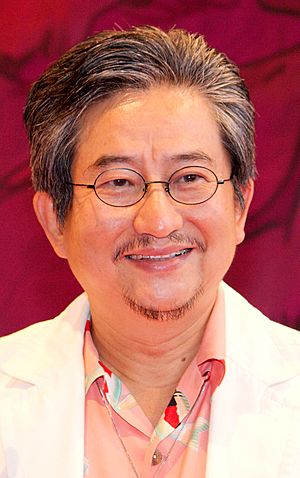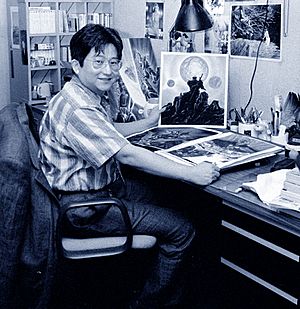Go Nagai facts for kids
Quick facts for kids
Go Nagai
|
|
|---|---|
| 永井豪 | |

Go Nagai at Japan Expo in 2008
|
|
| Born |
Kiyoshi Nagai (永井潔, Nagai Kiyoshi)
September 6, 1945 Wajima, Ishikawa, Japan
|
| Occupation | Manga artist |
| Known for |
|
| Relatives | Yasutaka Nagai (brother) |
| Awards | 4th Kodansha Manga Award Shōnen: Susano Oh 25th Japan Movie Critics Awards: Diamond Grand Prize 47th Japan Cartoonists Association Award Minister of Education, Culture, Sports, Science and Technology Award: All of his works |
Kiyoshi Nagai, born on September 6, 1945, is a famous Japanese manga artist. He is better known by his pen name, Go Nagai. He has created many popular stories in science fiction, fantasy, and horror.
Go Nagai started his professional career in 1967. He is most famous for creating hit manga and anime series from the 1970s. These include Cutie Honey, Devilman, and Mazinger Z. He is often given credit for starting the super robot genre. He designed the first mecha robots that were piloted by someone inside a cockpit, like in Mazinger Z. He also helped create the magical girl genre with Cutie Honey. Nagai also pioneered the post-apocalyptic manga/anime genre with Violence Jack. In 2005, he became a professor of Character Design at the Osaka University of Arts.
Contents
Go Nagai's Early Life
Go Nagai was born in Wajima, Ishikawa, Japan, on September 6, 1945. He was the fourth of five brothers. His family had just returned from Shanghai. After his father passed away, Go Nagai, his mother, and his four brothers moved to Tokyo.
As a child, he loved the works of artists like Gustave Doré and Osamu Tezuka. His brother, Yasutaka Nagai, even gave him a copy of Tezuka's Lost World.
A Turning Point
After high school, Go Nagai was studying to get into Waseda University. During this time, he became very sick. Thinking he might not have much time left, he decided he wanted to create a manga. He wanted to leave something behind that showed he had lived. He loved drawing manga as a child.
He soon got better, but this experience changed his life. He decided to focus on creating manga. He stopped attending prep school and began working on his dream.
With help from his brother Yasutaka, he started making his first manga stories. Even though his mother was against him becoming a manga artist, he kept trying to get his work published. Many publishers turned him down. It's even said his mother secretly asked publishers to reject his work!
However, his talent was noticed by Weekly Shōnen Sunday. They connected him with Shotaro Ishinomori, a famous manga artist. In 1965, Go Nagai was accepted into Ishinomori's studio as an assistant. His professional career officially began in 1967.
First Manga Works
After working as an assistant, Go Nagai's very first professional manga was Meakashi Polikichi. This was a short, funny story published in November 1967. Around the same time, he also drew a manga version of the TV anime "Little Monster Yadamon."
His first works were mostly short, funny manga. But this was about to change with his next big series, Harenchi Gakuen.
Big Success and Challenges
Less than a year after starting his career, Go Nagai had his first huge success. He went from being unknown to being invited to TV shows and interviews.
In 1968, a new manga magazine called Shōnen Jump was starting. They invited Nagai to be one of their first artists. He had to create a long-running series, which was different from his usual short stories. He accepted, and the series, Harenchi Gakuen (also known as Shameless School), became a massive hit. It helped Shōnen Jump sell over a million copies!
Harenchi Gakuen was groundbreaking because it introduced new types of humor and situations into manga for young readers. It was very popular and led to live-action movies and TV shows. Many people consider it one of the most influential manga of the late 1960s.
Facing Criticism
However, Harenchi Gakuen also faced strong criticism from some parts of Japanese society. Many parents and parent-teacher groups protested, calling the manga "vulgar." They were concerned about the content being shown to children.
Go Nagai was interviewed by many newspapers, magazines, and TV channels. He was even called an "enemy of society." But he knew what he was doing with his manga. He didn't draw anything too extreme, and his fans supported him. They sent him letters, saying they knew adults were reading even more mature things than his manga.
The protests were so strong that the series was almost canceled. In response, Nagai changed the story of Harenchi Gakuen. It became more serious, showing a full-scale war. This led to a famous, dramatic ending where students and teachers fought for their freedom of expression. This was Nagai's way of responding to the criticism. (Later, the series did return for more stories.)
Around this time, Nagai also created Abashiri Ikka. This series, along with Harenchi Gakuen, became very popular during his early career.
Dynamic Productions
Because of the success of Harenchi Gakuen, Go Nagai founded Dynamic Productions in April 1969 with his brothers. This company was created to help him with his work and manage the rights to his creations. Before this, Nagai earned almost no money from the TV shows, movies, or toys based on Harenchi Gakuen.
Dynamic Productions became one of the first companies to require publishers to sign contracts for manga. This was important because, even today, many manga are created based only on spoken agreements.
In the same year, Ken Ishikawa joined Dynamic Productions. He became one of Nagai's main partners and best friends. Ishikawa helped Nagai with many of his early works.
New Kinds of Stories
Even after the changes in Harenchi Gakuen, Nagai mostly wrote funny stories. But this began to change in 1970. He created a science fiction story called Oni -2889 Nen no Hanran-. Then, in 1971, came the horror story Susumu-chan Dai Shock.
Soon after, Nagai got the chance to write a full horror series called Demon Lord Dante. This series led to his most famous horror work, Devilman. Nagai had always wanted to write more serious science fiction stories. He saw Devilman as his chance to move beyond just funny manga.
Go Nagai's Style and Works
In his series Harenchi Gakuen (1968–1972), Nagai broke many rules in manga for kids. His use of humor and dramatic situations was new and caused a lot of discussion. This style became a common feature in many of Nagai's later works and those of other creators.
After Harenchi Gakuen, Nagai created the Mazinger Z series. This was later expanded into Great Mazinger, Grendizer, and Mazinkaiser. In these series, he developed the idea of giant mecha robots. Mazinger was the first manga where a giant robot was controlled by a hero from inside. It is considered the first successful "Super Robot" anime show and inspired many others.
At the same time as Mazinger, he created Devilman, one of his most popular manga. It's about a hero with demonic powers fighting against hordes of demons. The Devilman manga and TV anime were released at the same time, but they told very different stories. The manga, aimed at older teens, allowed Nagai to include more intense themes. Go Nagai considers Devilman and Mazinger to be his most important works because they are so popular worldwide. In 1972, Nagai achieved the amazing feat of drawing and writing five weekly manga series at once!
A month after finishing Devilman, Nagai created a sequel called Violence Jack. This long series featured a giant, strong man fighting for justice in a world destroyed by a massive earthquake.
Years later, Nagai updated Devilman with a new series called Devil Lady (known as Devilman Lady in Japan). This version featured young adult women as the main characters and changed the storyline.
One of Nagai's most famous works is Cutey Honey. It is seen as one of the first "magical girl" comics and greatly influenced later series in this genre, like Sailor Moon.
In 1980, he won the 4th Kodansha Manga Award for his work Susano OH.
Go Nagai has worked with other famous artists like Shotaro Ishinomori and Ken Ishikawa. He continues to create many manga today. Much of his work has been turned into anime and live-action shows called tokusatsu. Nagai has even made small appearances in some live-action films, including the 2004 Cutie Honey movie.
Global Impact
Go Nagai's works have been popular around the world. For example, Grendizer was very popular in Italy, France, and the Middle East when it aired. In Spain, a statue of Mazinger Z has even been built in Tarragona.
Go Nagai's Legacy
Go Nagai is known for starting the super robot genre with Mazinger Z and the magical girl genre with Cutie Honey. His series Violence Jack also helped create the post-apocalyptic manga and anime genre. Its setting of a ruined desert world with biker gangs and chaos was similar to, and may have influenced, later post-apocalyptic stories like the Mad Max films (starting in 1979) and the Japanese series Fist of the North Star (starting in 1983).
Many famous creators have said Go Nagai's work inspired them.
- Anime director Hideaki Anno (who created Evangelion) said Devilman and Mazinger were inspirations for his work.
- Manga artist Kentaro Miura (creator of Berserk) said he liked Go Nagai's energetic style and that Nagai greatly influenced him.
- Movie director Yoshihiro Nishimura is a big fan of Go Nagai's works.
- Scriptwriter Kazuki Nakashima read all of Go Nagai's works and said Devilman really impacted him when he was in middle school.
- Japanese writer Gen Urobuchi said Devilman taught him that endings can be bittersweet.
- Videogame designer Goichi Suda named Violence Jack and Susano Oh as his favorite manga.
Many other series have been inspired by Devilman. A poster for the anime Devilman Crybaby listed about seventy-five series that were influenced by it. This list included titles like Parasyte, Tokyo Ghoul, and Attack on Titan. Even Yu-Gi-Oh! creator Kazuki Takahashi said he drew Devilman characters a lot as a child. More recent stories, like Tatsuki Fujimoto's Chainsaw Man, have also been inspired by Devilman.
A museum dedicated to Go Nagai, called Go Nagai Wonderland Museum, opened in 2009 in Wajima, Ishikawa. Sadly, the museum was destroyed in the 2024 Sea of Japan earthquake.
See also
 In Spanish: Gō Nagai para niños
In Spanish: Gō Nagai para niños


